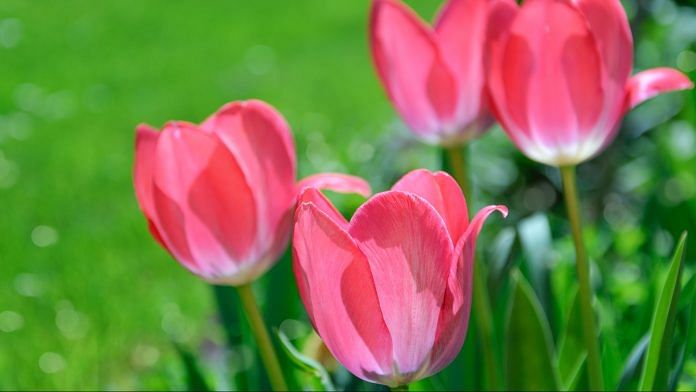A couple is sitting together and things start getting frisky. Suddenly, the camera pans to logs of wood burning in a fireplace. Or cuts to a shot of two flowers nuzzling each other, or a close-up of tight hand-holding.
Looks like you are watching a romantic movie shot in coronavirus times.
Here’s the latest coronavirus-induced bad news — key Bollywood industry associations such as Producers Guild of India (PGI), Cine and Television Artistes’ Association (CINTAA) have been drawing up a set of guidelines on film shooting procedures post the lockdown. These proposals are expected to be discussed with the Ministry of Information and Broadcasting in the coming days.
The discussion will include the most crucial question — what will happen to scenes of intimacy in Bollywood? Will we be forced to go back to the old flower-kissing days?
The post-lockdown world promises to give producers, directors and actors a hard time. The second Emraan Hashmi kissing revolution will have to wait.
Full circle
Bollywood movie buffs aren’t strangers to the fact that a camera panning to fire burning, or sweat dripping, or swans nestling, or toes curling, or door closing signifies sexual activities are underway.
Indian filmmakers and viewers alike have taken their own sweet time to get comfortable with both depicting and watching certain intimate scenes on the silver screen. The censor board’s frequent rebuttals haven’t made things any easier.
Take, for instance, Saif Ali Khan and Preity Zinta-starrer Kya Kehna (2000). It was a film about pregnancy that was uncomfortable showing sex. The viewers were made witness to a trail of clothes on the ground followed by a tight hand-holding shot. Aamir Khan-starrer PK (2014) shows ‘dancing cars’ instead of people making love in cars. But Rani Mukherjee’s Aiyyaa (2012) takes the cake for the most twisted sexual innuendo ever — a not-so-veiled reference of Rani Mukherjee’s character’s scooter being filled with fuel.
At the same time, there have been some movies that revolutionised the trend of locking lips on screen. Raj Kapoor’s 1973 film Bobby, in which Rishi Kapoor and Dimple Kapadia kissed, was a film that broke through conservative barriers of the censorship board. From Ramesh Sippy’s romantic flick Sagar (1985), Anurag Basu’s erotic thriller Murder (2004) to Aditya Chopra’s 2016 film Befikre featuring countless liplocks, Bollywood has come a long way.
But if there’s one thing any Indian knows about film shootings is that they are crazy and chaotic. And if you throw in the shooting of an intimate scene, then it’s also incredibly personal and close. It becomes all the more difficult when a virus could be your unannounced co-star in the coming months.
The post-corona world will not allow for a large set with people bustling all over the place. It needs to be systematic, contained and maintain social distance.
Coronavirus demands that Bollywood come full circle by bringing symbolic, and not physical, intimacy back on the screens.
Also read: INOX, PVR unhappy about films being released on online platforms like Amazon Prime Video
What’s the solution?
The only possible trajectory for filmmakers and producers is to look forward. They must not entertain the coronavirus messing with their content. Film director Shoojit Sircar summarised the industry’s dilemma in his own words. “How the cinema world conducts shooting intimate scenarios in films (is) to be seen and planned, after all this is over. Especially the intimate kissing/hugging scenes,” he wrote, adding that storytelling may have to be ‘cheated’ with. A scene can be shot in a way that portrays the actors sitting close to each other, but it might not be the case in reality.
There may be some merit to Hollywood movies like Her (2013), starring Joaquin Phoenix and Amy Adams, in the Covid era. The film is a strange yet comforting story of a man falling deeply in love with an Artificial Intelligence system. The closest Phoenix gets to romancing his lady love is by speaking to her. Maybe these Black Mirror-esque plots were signalling the future of romances on the silver screen.
Moreover, there might be something to learn from Sweden and Denmark. They have already allowed film shoots with up to 50 people on set. The guidelines also specify regular temperature checks, sequential working of departments, etc.
Late-night shows and singing competitions can always be shot using apps such as Zoom. Additionally, some TV shows have taken strict measures, such as restricting movement of cast and crew, asking post-production people to work from home, scaling back make-up and hair services, in order to continue shooting.
Screenplays may also have to be written for movies that allow for limited crews to function. In the Rajkummar Rao-starrer Trapped (2016), the entire movie explores one man’s struggles being trapped in an apartment. It allowed for only one actor inhabiting one location, but still conveyed a brilliant story. In the absence of intimacy, content must be king again.
Views are personal.
Also read: TikTok vs YouTube is the new class war on internet. It all began with a roast



